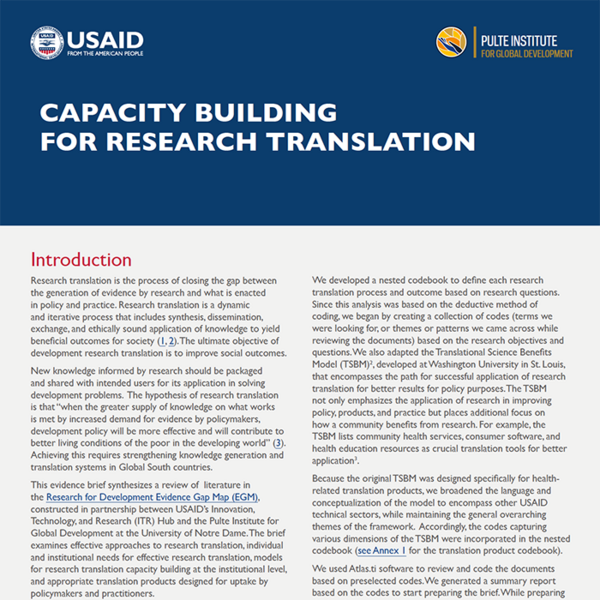
Paul Perrin, director of the Pulte Institute for Global Development’s Evidence and Learning Division, has written three briefs summarizing key learnings from the Evidence Gap Map (EGM). The EGM is a tool developed by the Research and Technical Assistance Center (RTAC), in partnership with USAID's Innovation,Technology, and Research Hub Research Division (ITR/R), to assess the effectiveness of development research in low and middle-income countries.
The briefs are organized around three central themes—effective partnership approached in international research, capacity building for research translation, and research financing—that assess the effectiveness of development research. Each brief highlights key learnings, challenges, gaps and recommendations that can assist both policymakers and practitioners in decision-making. Perrin’s briefs also provide recommendations for future ITR/R programming.
The first brief, Effective Partnership Approaches in International Research, assesses how research partnerships can be designed to organize and sustain high quality research that informs policy and practice and improves lives. In recent years, increased attention and investment has been placed on effective research partnerships for global development research.
The second brief is titled Capacity Building for Research Translation. Research translation is defined as the process of closing the gap between the generation of evidence by research and what is enacted in policy and practice. The brief evaluates effective approaches to research translation, individual and institutional needs for effective research translation, models for research capacity building at the institutional level, and appropriate translation products designed for uptake by policymakers and practitioners.
The third and final brief, Research Financing, examines the provision of monetary resources to researchers and other research stakeholders, including how research dynamics, cost-effectiveness, and results differ depending on who received and manages the funds. Understanding how monetary support impacts the uptake and policy utility of development research can help donors and the private sector make meaningful investment decisions.
In conjunction with Perrin, the reports were also authored by Lila Khatiwada, Kevin Waitkuweit, Jaclyn Biedronski, Kevin Fink, and Anna Lande from the Pulte Institute for Global Development as well as Gabriela Alcaraz and Brooke Jardine from NORC at the University of Chicago.
Learn more about the EGM and read the briefs here.
Originally published by at pulte.nd.edu on June 08, 2022.